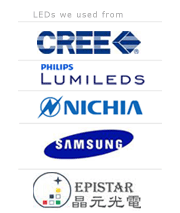News
Search
Popular search



April.10, 2012 – 11:14 — jasminezhuang
“With the rapid development of the LED industry, China has become a major production and export hub. As more local LED lighting companies ship high-quality products across the world, certification is growing in importance,” said the head of the Green Lighting Shanghai Project Team. “Green Lighting Shanghai is China’s most influential LED exhibition in the first half of 2012. In putting the show together, we’ve paid close attention to new trends in domestic LED lighting certification standards. We’ll highlight these at the show, which will be a definitive, international platform.”
Each of the world’s major LED lighting producing nations has its own certification standards for its products. The China Compulsory Certification (CCC) mark regulates all products for sale in China. The North American UL certification, established by Underwriter Laboratories Inc., is the safety testing standard for the US. Products must achieve UL certification to be permissible for sale in the North American market. UL certification is one of the world’s most stringent. The EU’s CE safety certification gives manufacturers access to the European market. CB certification was designed to facilitate international trade for electrical products. This global standard eliminates the need for companies to apply for unique certifications in each individual country to which they wish to export.
Apart from these credentials, there are optional certifications from the China Quality Certification Center (CQC), Product Safety Certification of the China Solid State Lighting Alliance (CSA), the Product Safety and Quality Certification of TÜV Rheinland, the US Federal Communications Commission’s (FCC) Electromagnetic Interference standard certification and a host of other accreditation standards.
“With the gradual fall in the price of LED lighting products, they’ve become a firm part of indoor and outdoor lighting markets. However, the inconsistent quality of lighting remains problematic,” said the head of the Green Lighting Shanghai Project Team. “LED lights are more popular in Europe and North America than in Asia. These Western markets have high barriers to entry, due to their strict technological and safety standards. Several new compulsory lighting standards will take effect in 2012, which we expect to isolate the inferior products and badly run companies.”
Mainland China and Taiwan Markets — The Standardization Administration of the People’s Republic of China (SAC), issued a couple of new project standards on July 29, 2011. These included:
• Performance Requirements for Reflective Self-Ballasted LED Lamps
• Performance Testing Methods for Reflective Self-Ballasted LED Lamps
• Performance Requirements for LED Down Lamps
EU Market — From 2013, the EU will enforce the standards of the human body electromagnetic radiation safety norms. The Union has set multiple compulsory requirements for LED lamps. These include CE-LVD (Conformité Européenne – Low Voltage Directive), which detects LVD in LED products. Also among new requirements is the CE-EMC (Conformité Européenne – Electromagnetic Compatibility) which tests ElectroMagnetic Compatibility Directives (EMCD). Furthermore, if the products receive the GS (Geprüfte Sicherheit – Tested Safety) and PAH (Polycyclic Aromatic Hydrocarbon) certification, as well as other quality accreditations, they can then be sold at higher prices, due to being more attractive to, and trusted by, consumers.
North American Market — the North American market should also meet the requirements of electric safety, electromagnetic compatibility and power consumption. The new listing standards for solid-state lighting lamps and light source products issued by the US Environmental Protection Agency (EPA) in October 2011 will come into compulsory effect this April. LM-80, a method of measuring Lumen depreciation of LED Light sources, is seen as the passport into the American market. In the future, unverified LED packaging and crystal grain plants will struggle to penetrate the US market.
Though LED lighting still faces numerous hurdles, the growth of the market is experiencing a seemingly irrepressible upward trend. Therefore, many local manufacturers are committed to achieving standardized certification, in order to explore local and international markets as effectively as possible.
For the sake of the certification standards for LED lighting products and specifications of LED lighting worldwide, Green Lighting Shanghai 2012 will feature four specialized sections, to cover the whole industry chain:
• Epitaxy Wafers and Chips
• Sapphires and Materials
• Manufacturing and Testing Equipment
• IDEAL Lighting
The Ideal Lighting Zone will highlight new innovations by replicating the different lighting environments of hotels, clubs, museums, roads, landscapes, displays, commercial interiors, buildings, etc. In so doing, it will add a fresh, artistic element to the lighting show.
Several high profile local and international companies will exhibit at Green Lighting Shanghai this year. These include Tongren, Nichia, Seoul Semiconductor, Epistar, Rohm, Stanley, Everlight, Hangke, Wanban and many more. Additionally, the new layout of the show floor will allow visitors to strategically navigate the exhibition; and vendors and buyers alike will discover even more specific commercial opportunities.
With the rapid development of the LED industry and constant changes to LED lighting standards around the world, there is an urgent need for manufacturers to keep pace with new policies and trends. The forum themed Low Carbon and Innovation: A Revolution in Lighting, will bring together hundreds of top local and international experts to deliver speeches on key issues. These talks are expected to attract over 1,000 industry professionals keen to learn about new trends and regulations.
Green Lighting Shanghai 2012 will run concurrent to NEPCON China 2012, Asia’s largest event for the electronics manufacturing and SMT industries. Spanning a combined area of over 40,000 sqm, the two exhibitions are expected to attract more than 700 of the electronics manufacturing industry’s top companies, together with 20,000 trade visitors. The high number of qualified participants will make the two shows an excellent promotional opportunity for buyers and vendors alike.



